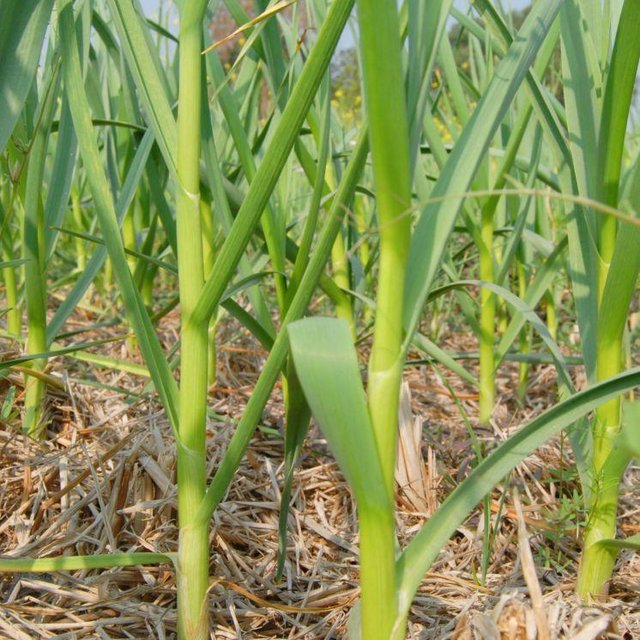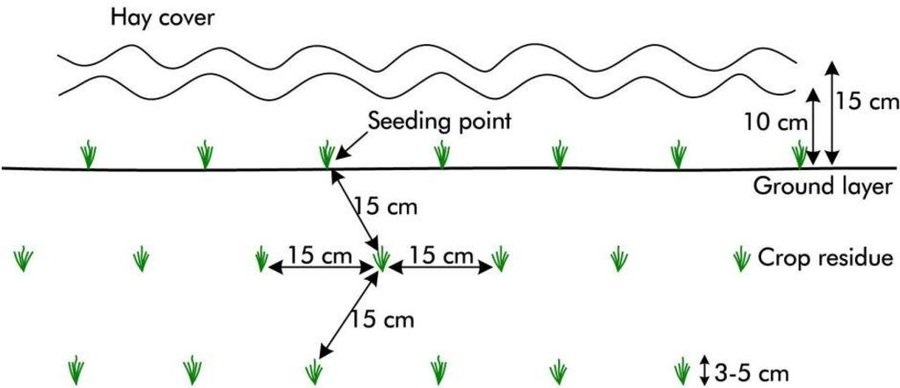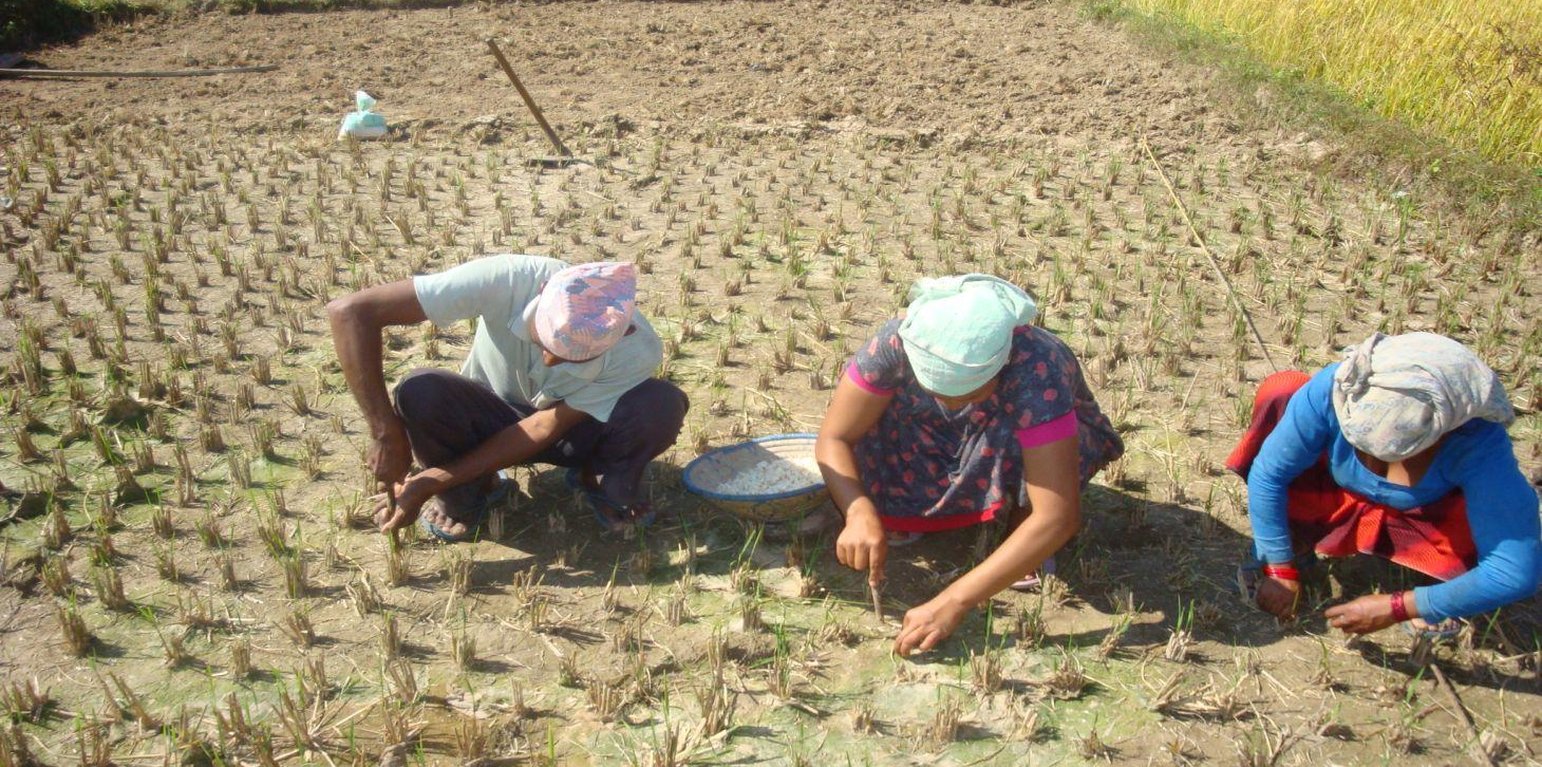No-till garlic cultivation
(เนปาล)
Khan jot nagari lasun kheti (Main Contributor: Krishna Lamsal, LI-BIRD)
คำอธิบาย
No-till is a farming system in which the seeds are planted directly into untilled soil which still contains the previous crop residues. No-till cultivation of garlic is practiced in the tropical lowland districts of western Nepal where garlic is sown directly into the soil after the paddy is harvested.
No-till* methods minimize soil disturbance and allow crop residues or stubble to remain on the ground instead of being removed or dug into the soil. As practised in the western Terai of Nepal, the seedbed is prepared by leaving a 3–5 cm thick layer of rice paddy crop residue on the soil surface after the paddy harvest. Garlic seed is planted directly into the soil soon after the paddy is harvested at a spacing of approximately 15 cm and the entire field is then covered with a 10 cm (or more) layer of hay. The seeds germinate with the help of the ambient moisture. The frequency and timing of irrigation depends on need, but since there has been no tillage and the ground is covered with mulch, much of the ambient moisture is retained in the soil. The mature garlic is harvested in February–March. This technology is gaining in popularity because farmers can directly see the economic benefit of not having to till the soil.
Purpose of the Technology: No-till methods are important from the standpoint of environmental farming for a number of reasons. The fact that the soil is not tilled after the paddy is harvested and remains covered with crop residues leads to efficient erosion control (up to 90%) and increased biological activity in and on the soil. The technology helps to conserve moisture in the soil, to improve the infiltration of water (up to 60%), and to reduce soil compaction, and overall, it requires less energy for cultivation (Derpsch et al. 2010). Increasing soil organic matter also helps to sequester carbon and contributes to reducing agricultural greenhouse gas emissions; ultimately, it supports increased production and resilience to climate change. In addition to keeping carbon in the soil, in a recent study, no-till farming was found to reduce nitrous oxide (N2O) emissions by 40–70%, depending on the rotation.
Establishment / maintenance activities and inputs: * No-till in this context means the soil is not tilled after the paddy is harvested and before the garlic seeds are planted. After the garlic is harvested, the soil is tilled before the next crop is planted. No-till is a form of conservation tillage, which refers to methods that leave at least 30% of crop residues in place.
สถานที่
![]()
สถานที่: Kailali district, เนปาล
ตำนวนการวิเคราะห์เทคโนโลยี:
ตำแหน่งทางภูมิศาสตร์ของสถานที่ที่ถูกเลือ
การเผยแพร่ของเทคโนโลยี: กระจายไปอย่างสม่ำเสมอในพื้นที่ (approx. 1-10 ตร.กม.)
In a permanently protected area?:
วันที่ในการดำเนินการ: น้อยกว่า 10 ปี (ไม่นานนี้)
ประเภทของการแนะนำ
-
ด้วยการริเริ่มของผู้ใช้ที่ดินเอง
-
เป็นส่วนหนึ่งของระบบแบบดั้งเดิมที่ทำก้นอยู่ (> 50 ปี)
-
ในช่วงการทดลองหรือการทำวิจัย
-
ทางโครงการหรือจากภายนอก

Well-established garlic plants grown by the no-till method. Note that the original mulch is still in place helping to retain moisture. (Krishna Lamsal)
จุดประสงค์หลัก
-
ปรับปรุงการผลิตให้ดีขึ้น
-
ลด ป้องกัน ฟื้นฟู การเสื่อมโทรมของที่ดิน
-
อนุรักษ์ระบบนิเวศน์
-
ป้องกันพื้นที่ลุ่มน้ำ/บริเวณท้ายน้ำ โดยร่วมกับเทคโนโลยีอื่นๆ
-
รักษาสภาพหรือปรับปรุงความหลากหลายทางชีวภาพ
-
ลดความเสี่ยงของภัยพิบัติ
-
ปรับตัวเข้ากับการเปลี่ยนแปลงภูมิอากาศของโลก สภาพภูมิอากาศที่รุนแรงและผลกระทบ
-
ชะลอการเปลี่ยนแปลงภูมิอากาศของโลกและผลกระทบ
-
สร้างผลกระทบทางด้านเศรษฐกิจที่เป็นประโยชน์
-
สร้างผลกระทบทางด้านสังคมที่เป็นประโยชน์
การใช้ที่ดิน
-
พื้นที่ปลูกพืช
- การปลูกพืชล้มลุกอายุปีเดียว
จำนวนของฤดูเพาะปลูกต่อปี: 3
การใช้น้ำ
-
จากน้ำฝน
-
น้ำฝนร่วมกับการชลประทาน
-
การชลประทานแบบเต็มรูปแบบ
ความมุ่งหมายที่เกี่ยวข้องกับการเสื่อมโทรมของที่ดิน
-
ป้องกันความเสื่อมโทรมของที่ดิน
-
ลดความเสื่อมโทรมของดิน
-
ฟื้นฟูบำบัดที่ดินที่เสื่อมโทรมลงอย่างมาก
-
ปรับตัวกับสภาพความเสื่อมโทรมของที่ดิน
-
ไม่สามารถใช้ได้
ที่อยู่ของการเสื่อมโทรม
-
การกัดกร่อนของดินโดยน้ำ - Wt (Loss of topsoil): การสูญเสียดินชั้นบนหรือการกัดกร่อนที่ผิวดิน
มาตรการ SLM
-
มาตรการจัดการพืช - A3: การรักษาหน้าดิน (A 3.1: No tillage)
แบบแปลนทางเทคนิค
ข้อมูลจำเพาะด้านเทคนิค
No-till garlic cultivation in fields where paddy has just been harvested.
Technical knowledge required for field staff / advisors: high
Technical knowledge required for land users: high
Main technical functions: increase in organic matter, increase in nutrient availability (supply, recycling,…)
Secondary technical functions: increase of infiltration, increase / maintain water stored in soil

Author: Krishna Lamsal, AK Thaku
การจัดตั้งและการบำรุงรักษา: กิจกรรม ปัจจัยและค่าใช้จ่าย
การคำนวนต้นทุนและค่าใช้จ่าย
- ค่าใช้จ่ายถูกคำนวน ต่อพื้นที่ที่ใช้เทคโนโลยี (หน่วยของขนาดและพื้นที่: ha)
- สกุลเงินที่ใช้คำนวณค่าใช้จ่าย USD
- อัตราแลกเปลี่ยน (ไปเป็นดอลลาร์สหรัฐ) คือ 1 ดอลลาร์สหรัฐ = ไม่มีคำตอบ
- ค่าจ้างเฉลี่ยในการจ้างแรงงานต่อวันคือ 4.20
ปัจจัยที่สำคัญที่สุดที่มีผลต่อค่าใช้จ่าย
n.a.
กิจกรรมเพื่อการจัดตั้ง
n.a.
กิจกรรมสำหรับการบำรุงรักษา
-
maintenance and recurrent activities are minimal. The seedling need to be watered, fertilized and weeded (ช่วงระยะเวลา/ความถี่: October-March)
ปัจจัยและค่าใช้จ่ายของการบำรุงรักษา (per ha)
| ปัจจัยนำเข้า |
หน่วย |
ปริมาณ |
ค่าใช้จ่ายต่อหน่วย (USD) |
ค่าใช้จ่ายทั้งหมดต่อปัจจัยนำเข้า (USD) |
%ของค่าใช้จ่ายที่ก่อให้เกิดขึ้นโดยผู้ใช้ที่ดิน |
|
แรงงาน
|
| Maintenance |
Persons/ha |
6.0 |
4.23333333 |
25.4 |
100.0 |
|
วัสดุด้านพืช
|
| Seeds |
kg/ha |
10.0 |
0.7 |
7.0 |
100.0 |
|
ปุ๋ยและสารฆ่า/ยับยั้งการเจริญเติบโตของสิ่งมีชีวิต (ไบโอไซด์)
|
| Fertilizer |
kg/ha |
1.0 |
0.7 |
0.7 |
100.0 |
| Compost / manure |
kg/ha |
200.0 |
0.014 |
2.8 |
100.0 |
|
อื่น ๆ
|
| Mulch |
kg/ha |
60.0 |
0.23333333 |
14.0 |
100.0 |
| Irrigation |
ha |
1.0 |
1.4 |
1.4 |
100.0 |
| ค่าใช้จ่ายทั้งหมดของการบำรุงรักษาสภาพเทคโนโลยี |
51.3 |
|
| Total costs for maintenance of the Technology in USD |
51.3 |
|
สิ่งแวดล้อมทางธรรมชาติ
ปริมาณน้ำฝนเฉลี่ยรายปี
-
< 250 ม.ม.
-
251-500 ม.ม.
-
501-750 ม.ม.
-
751-1,000 ม.ม.
-
1,001-1,500 ม.ม.
-
1,501-2,000 ม.ม.
-
2,001-3,000 ม.ม.
-
3,001-4,000 ม.ม.
-
> 4,000 ม.ม.
เขตภูมิอากาศเกษตร
-
ชื้น
-
กึ่งชุ่มชื้น
-
กึ่งแห้งแล้ง
-
แห้งแล้ง
ข้อมูลจำเพาะเรื่องภูมิอากาศ
Thermal climate class: subtropics
ความชัน
-
ราบเรียบ (0-2%)
-
ลาดที่ไม่ชัน (3-5%)
-
ปานกลาง (6-10%)
-
เป็นลูกคลื่น (11-15%)
-
เป็นเนิน (16-30%)
-
ชัน (31-60%)
-
ชันมาก (>60%)
ภูมิลักษณ์
-
ที่ราบสูง/ที่ราบ
-
สันเขา
-
ไหล่เขา
-
ไหล่เนินเขา
-
ตีนเนิน
-
หุบเขา
ความสูง
-
0-100 เมตร
-
101-500 เมตร
-
501-1,000 เมตร
-
1,001-1,500 เมตร
-
1,501-2,000 เมตร
-
2,001-2,500 เมตร
-
2,501-3,000 เมตร
-
3,001-4,000 เมตร
-
> 4,000 เมตร
เทคโนโลยีถูกประยุกต์ใช้ใน
-
บริเวณสันเขา (convex situations)
-
บริเวณแอ่งบนที่ราบ (concave situations)
-
ไม่เกี่ยวข้อง
ความลึกของดิน
-
ตื้นมาก (0-20 ซ.ม.)
-
ตื้น (21-50 ซ.ม.)
-
ลึกปานกลาง (51-80 ซ.ม.)
-
ลึก (81-120 ซ.ม.)
-
ลึกมาก (>120 ซ.ม.)
เนื้อดิน (ดินชั้นบน)
-
หยาบ/เบา (ดินทราย)
-
ปานกลาง (ดินร่วน ทรายแป้ง)
-
ละเอียด/หนัก (ดินเหนียว)
เนื้อดิน (> 20 ซม. ต่ำกว่าพื้นผิว)
-
หยาบ/เบา (ดินทราย)
-
ปานกลาง (ดินร่วน ทรายแป้ง)
-
ละเอียด/หนัก (ดินเหนียว)
สารอินทรียวัตถุในดิน
-
สูง (>3%)
-
ปานกลาง (1-3%)
-
ต่ำ (<1%)
น้ำบาดาล
-
ที่ผิวดิน
-
<5 เมตร
-
5-50 เมตร
-
> 50 เมตร
ระดับน้ำบาดาลที่ผิวดิน
-
เกินพอ
-
ดี
-
ปานกลาง
-
ไม่ดีหรือไม่มีเลย
คุณภาพน้ำ (ยังไม่ได้รับการบำบัด)
-
เป็นน้ำเพื่อการดื่มที่ดี
-
เป็นน้ำเพื่อการดื่มที่ไม่ดี (จำเป็นต้องได้รับการบำบัด)
-
เป็นน้ำใช้เพื่อการเกษตรเท่านั้น (การชลประทาน)
-
ใช้ประโยชน์ไม่ได้
Water quality refers to:
ความเค็มของน้ำเป็นปัญหาหรือไม่?
การเกิดน้ำท่วม
ความหลากหลายทางชนิดพันธุ์
ความหลากหลายของแหล่งที่อยู่
ลักษณะเฉพาะของผู้ใช้ที่ดินที่ประยุกต์ใช้เทคโนโลยี
เป้าหมายทางการตลาด
-
เพื่อการยังชีพ (หาเลี้ยงตนเอง)
-
mixed (subsistence/ commercial)
-
ทำการค้า/การตลาด
รายได้จากภายนอกฟาร์ม
-
< 10% ของรายได้ทั้งหมด
-
10-50% ของรายได้ทั้งหมด
-
> 50% ของรายได้ทั้งหมด
ระดับของความมั่งคั่งโดยเปรียบเทียบ
-
ยากจนมาก
-
จน
-
พอมีพอกิน
-
รวย
-
รวยมาก
ระดับของการใช้เครื่องจักรกล
-
งานที่ใช้แรงกาย
-
การใช้กำลังจากสัตว์
-
การใช้เครื่องจักรหรือเครื่องยนต์
อยู่กับที่หรือเร่ร่อน
-
อยู่กับที่
-
กึ่งเร่ร่อน
-
เร่ร่อน
เป็นรายบุคคลหรือกลุ่ม
-
เป็นรายบุคคล/ครัวเรือน
-
กลุ่ม/ชุมชน
-
สหกรณ์
-
ลูกจ้าง (บริษัท รัฐบาล)
อายุ
-
เด็ก
-
ผู้เยาว์
-
วัยกลางคน
-
ผู้สูงอายุ
พื้นที่ที่ใช้ต่อครัวเรือน
-
< 0.5 เฮกตาร์
-
0.5-1 เฮกตาร์
-
1-2 เฮกตาร์
-
2-5 เฮกตาร์
-
5-15 เฮกตาร์
-
15-50 เฮกตาร์
-
50-100 เฮกตาร์
-
100-500 เฮกตาร์
-
500-1,000 เฮกตาร์
-
1,000-10,000 เฮกตาร์
-
>10,000 เฮกตาร์
ขนาด
-
ขนาดเล็ก
-
ขนาดกลาง
-
ขนาดใหญ่
กรรมสิทธิ์ในที่ดิน
-
รัฐ
-
บริษัท
-
เป็นแบบชุมชนหรือหมู่บ้าน
-
กลุ่ม
-
รายบุคคล ไม่ได้รับสิทธิครอบครอง
-
รายบุคคล ได้รับสิทธิครอบครอง
สิทธิในการใช้ที่ดิน
-
เข้าถึงได้แบบเปิด (ไม่ได้จัดระเบียบ)
-
เกี่ยวกับชุมชน (ถูกจัดระเบียบ)
-
เช่า
-
รายบุคคล
สิทธิในการใช้น้ำ
-
เข้าถึงได้แบบเปิด (ไม่ได้จัดระเบียบ)
-
เกี่ยวกับชุมชน (ถูกจัดระเบียบ)
-
เช่า
-
รายบุคคล
เข้าถึงการบริการและโครงสร้างพื้นฐาน
ผลกระทบ
ผลกระทบทางด้านเศรษฐกิจและสังคม
การเสี่ยงต่อความล้มเหลวในการผลิต
because moisture in retained
ความหลากหลายของแหล่งผลิตรายได้
powdered garlic is considered cash crop as it has medicinal values
ผลกระทบด้านสังคมและวัฒนธรรม
SLM หรือความรู้เรื่องความเสื่อมโทรมของที่ดิน
ผลกระทบด้านนิเวศวิทยา
การหมุนเวียนและการเติมของธาตุอาหาร
การปล่อยคาร์บอนและก๊าซเรือนกระจก
ผลกระทบนอกพื้นที่ดำเนินการ
รายได้และค่าใช้จ่าย
ผลประโยชน์ที่ได้รับเปรียบเทียบกับค่าใช้จ่าย
ผลประโยชน์ที่ได้รับเปรียบเทียบกับค่าใช้จ่ายในการบำรุงรักษา
ผลตอบแทนระยะสั้น
ด้านลบอย่างมาก
ด้านบวกอย่างมาก
ผลตอบแทนระยะยาว
ด้านลบอย่างมาก
ด้านบวกอย่างมาก
การเปลี่ยนแปลงของสภาพภูมิอากาศ
การเปลี่ยนแปลงสภาพภูมิอากาศที่ค่อยเป็นค่อยไป
อุณหภูมิประจำปี เพิ่มขึ้น
สภาพรุนแรงของภูมิอากาศ (ภัยพิบัติ)
การน้อมเอาความรู้และการปรับใช้
เปอร์เซ็นต์ของผู้ใช้ที่ดินในพื้นที่ที่นำเทคโนโลยีไปใช้
-
ครั้งเดียวหรือเป็นการทดลอง
-
1-10%
-
11-50%
-
> 50%
จากทั้งหมดที่ได้รับเทคโนโลยีเข้ามามีจำนวนเท่าใดที่ทำแบบทันที โดยไม่ได้รับการจูงใจด้านวัสดุหรือการเงินใดๆ?
-
0-10%
-
11-50%
-
51-90%
-
91-100%
เทคโนโลยีได้รับการปรับเปลี่ยนเร็วๆ นี้เพื่อให้ปรับตัวเข้ากับสภาพที่กำลังเปลี่ยนแปลงหรือไม่?
สภาพที่กำลังเปลี่ยนแปลงอันไหน?
-
การเปลี่ยนแปลงแบบค่อยเป็นค่อยไปและสภาพรุนแรงของภูมิอากาศ
-
การเปลี่ยนแปลงของตลาด
-
การมีแรงงานไว้ให้ใช้ (เนื่องจากการอพยพย้ายถิ่นฐาน)
บทสรุปหรือบทเรียนที่ได้รับ
จุดแข็ง: มุมมองของผู้ใช้ที่ดิน
จุดแข็ง: ทัศนคติของผู้รวบรวมหรือวิทยากรคนอื่นๆ
-
Decreased soil erosion, diversification of income source and livelihood options; reduced expenses on agricultural input
How can they be sustained / enhanced? Water needs to be available for irrigation and market linkages are needed to be able to fully profit from this cash crop
-
Soil conservation, improves water infiltration, increase organic matter in the soil; save effort and time
How can they be sustained / enhanced? more awareness of the conservation value of no-till methods
-
Carbon sequestration reduced agricultural greenhouse gas emission and climate change adaptation
How can they be sustained / enhanced? improved varieties of garlic that have stress resistance characteristics would help adaptation to climate change and would enhance environmental benefit
จุดด้อย/ข้อเสีย/ความเสี่ยง: มุมมองของผู้ใช้ที่ดินแก้ไขปัญหาได้อย่างไร
จุดด้อย/ข้อเสีย/ความเสี่ยง: ทัศนคติของผู้รวบรวมหรือวิทยากรคนอื่นๆแก้ไขปัญหาได้อย่างไร
การอ้างอิง
ผู้ตรวจสอบ
-
David Streiff
-
Alexandra Gavilano
วันที่จัดทำเอกสาร: 6 สิงหาคม 2015
การอัพเดทล่าสุด: 5 มิถุนายน 2019
วิทยากร
-
Shreedip Sigdel - ผู้เชี่ยวชาญ SLM
-
Krishna Lamsal - ผู้เชี่ยวชาญ SLM
คำอธิบายฉบับเต็มในฐานข้อมูล WOCAT
การจัดทำเอกสารถูกทำโดย
องค์กร
- ICIMOD International Centre for Integrated Mountain Development (ICIMOD) - เนปาล
- Local Initiatives for Biodiversity, Research, and Development (LI-BIRD) - เนปาล
โครงการ
การอ้งอิงหลัก
-
Current status of adoption of no-till farming in the world and some of its main benefits,Derpsch,R;Friedrich,T;Hongwen,L;, 2010: www.fao.org/ag/ca/CA-Publications/China_IJABE.pdf








